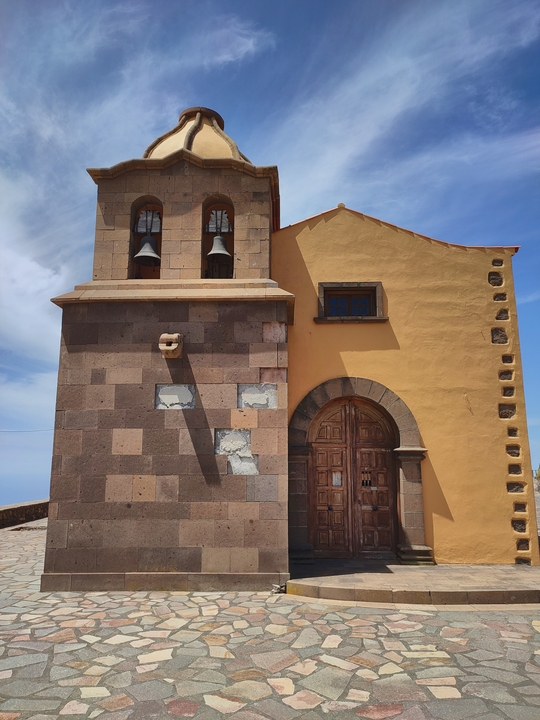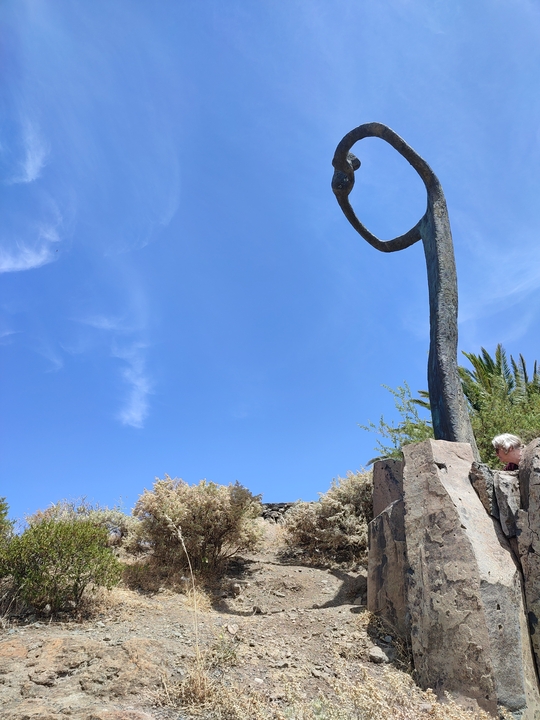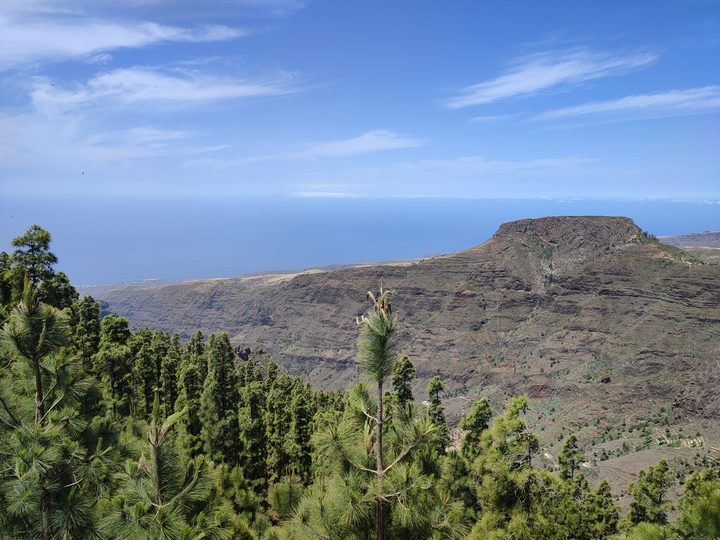
SILBO GOMERO. EIN STOLZES ERBE DER VERGANGENHEIT
La Gomera ist von unzähligen tiefen Schluchten durchzogen, die vom zentralen Plateau der Insel bis zum Meer abfallen. Diese spektakulären Unfälle des Geländes, wahre Abgründe, erschwerten nicht nur die optimale Nutzung der Ressourcen, die das Gebiet bot, sondern stellten auch ein erhebliches Kommunikationshindernis dar. Der zu Ihren Füßen heißt Erque und ist einer der bemerkenswertesten. Obwohl die teuren Wege die enormen Unebenheiten des Geländes überbrücken und ein dichtes Netz bilden, das alle Ecken der Insel miteinander verbindet, wurde, als es notwendig war, Nachrichten dringend zu übermitteln, ein viel effizienteres und schnelleres System verwendet, das Silbo Gomero, eine Pfiffe Sprache, die es ermöglicht, komplexe Botschaften über weite Entfernungen von einer Seite zur anderen der Schluchten zu übertragen und dabei das enorme Hindernis zu umgehen, das sie darstellten. Auf diese Weise wurden auf der Isla Colombina jahrhundertelang, vor der Ankunft der Europäer, Nachrichten gesendet und empfangen: Alles deutet also darauf hin, dass es sich um ein Erbe der alten Inselbewohner handelt, das wie viele andere bis heute fortbesteht die Traditionen der Insel. In diesem Teil der Insel war die Pfeife besonders relevant. Aus diesem Grund wurde der Standort für die Errichtung des Denkmals zu Ehren dieses wertvollen immateriellen Erbes ausgewählt, auf dessen Erhaltung wir logischerweise stolz sind. Dieses wunderbare Erbe hat Reisende beeindruckt, die schon seit langem nach La Gomera reisen. So bezog sich der französische Anthropologe Rène Verneau 1891 in seinem Werk „Fünf Jahre Aufenthalt auf den Kanarischen Inseln“ auf diese überraschende Besonderheit der Bevölkerung von La Gomera.
„Ich habe gesagt, dass diese Personen erhalten geblieben sind die unendlichen Bräuche ihrer Vorgänger. Ich habe gerade über Farnwurzel-Gofio gesprochen, in den Jahren der Hungersnot und des Honigs, Weins und Dattelessigs. Aber es gibt ein Merkmal dieser Bräuche, das noch schockierender ist: Ich möchte über gepfiffene Sprache sprechen“
EIN WELTERBE
Die Pfeifsprache Silbo Gomero, die entstand, um die Kommunikation über die tiefen Abgründe im Gomero-Territorium zu ermöglichen, wurde von Generation zu Generation bis heute weitergegeben. Heute überlebt sie dank intensiver Bemühungen zur Rettung und Aufwertung ihres Erbes, die mit dem Unterricht in den Schulen der Insel begannen und dazu führten, dass die Pfeife von der UNESCO zum Weltkulturerbe erklärt wurde

SILBO GOMERO. UN ORGULLOSO PATRIMONIO DEL PASADO
La Gomera está surcada por infinidad de profundos barrancos, que descienden hasta el mar desde la meseta central de la isla. Estos espectaculares accidentes del terreno, auténticos abismos, no sólo dificultaban el aprovechamiento de los recursos que ofrecía el territorio, sino que también suponían un notable obstáculo para las comunicaciones. El que está a tus pies se llama Erque y es uno de los más destacables. Aunque los costosos senderos salvan los enormes desniveles del terreno y forman una densa red que une todos los rincones de la isla, cuando era necesario comunicar noticias de forma urgente se utilizaba un sistema mucho más eficaz y rápido, el Silbo Gomero, un silbato. lenguaje que permite transmitir mensajes complejos a largas distancias, de lado a lado de los barrancos, sorteando el tremendo obstáculo que suponían. De esta manera, en la Isla Colombina se enviaron y recibieron noticias durante siglos, desde antes de la llegada de los europeos: así, todo apunta a que es un legado de los antiguos isleños, perpetuado hasta nuestros días, como muchos otros de las tradiciones de la isla. En este sector de la isla el pitido tuvo especial relevancia. Por ello, se eligió el lugar para la construcción del monumento en honor a este valioso patrimonio inmaterial cuya conservación es, lógicamente, motivo de orgullo. Este maravilloso legado ha impresionado a los viajeros que llevan mucho tiempo visitando La Gomera. Así, en 1891, el antropólogo francés Rène Verneau se refirió a este sorprendente rasgo distintivo de la población de La Gomera en su obra Cinco años de estancia en Canarias.
“He dicho que estos individuos han conservado las infinitas costumbres de sus antecesores. Acabo de hablar del gofio de raíz de helecho, en los años de hambre, y de la miel, del vino y del vinagre de dátiles. Pero hay una característica de estas costumbres que resulta aún más chocante: Quiero hablar del lenguaje silbado”
UN PATRIMONIO MUNDIAL
La lengua silbada de Silbo Gomero, que nació para permitir la comunicación sobre los profundos abismos de la geografía gomera, se ha transmitido de generación en generación hasta nuestros días. Hoy sobrevive gracias a un intenso trabajo de rescate y puesta en valor de su patrimonio, que comenzó con su enseñanza en las escuelas de la isla y desembocó en la declaración del silbato como Patrimonio Cultural de la Humanidad por la UNESCO.

SILBO GOMERO. A PROUD HERITAGE OF THE PAST
La Gomera is furrowed by an infinite number of deep ravines, which slope down to the sea from the central plateau of the island. These spectacular accidents of the terrain, true abysses, not only made it difficult to make the most of the resources offered by the territory, but also posed a notable obstacle to communications. The one at your feet is called Erque, and it’s one of the most remarkable. Although the expensive trails bridge the enormous unevenness in the terrain and form a dense network that links all the corners of the island, when it was necessary to communicate news urgently, a much more efficient and rapid system was used, the Silbo Gomero, a whistled language that allows complex messages to be transmitted over long distances, from side to side of the ravines, avoiding the tremendous obstacle they posed. In this way, news was sent and received on the Isla Colombina for centuries, from before the arrival of the Europeans: thus, everything points to the fact that it’s a legacy of the ancient islanders, perpetuated to the present day, like many other of the island’s traditions. In this sector of the island, the whistle was particularly relevant. For this reason, the site was chosen for the construction of the monument in honour of this valuable intangible heritage, the preservation of which is, logically, source of pride. This wonderful legacy has impressed travellers who have been going to La Gomera for a long time. Thus, in 1891, the French anthropologist Rène Verneau referred to this surprising distinctive feature of the population of La Gomera in his work Five Years of Stay in the Canary Islands.
“I have said that these individuals have preserved
the infinite customs of their predecessors.
I have just talked about fern root gofio,
in the years of famine, and of the honey, wine and date vinegar.
But there is one feature of these customs that is even more shocking:
I want to talk about whistled language”
A WORLD HERITAGE
The Silbo Gomero whistled language, which came into being in order to allow communication over the deep abysses in the Gomero terrain, has been transmitted from generation to generation to the present day. Today, it survives thanks to intense work to rescue and enhance its heritage, which began with its teaching in the island's schools and led to the declaration of the whistle as World Cultural Heritage by UNESCO
Translation by IM-Translator
Frage/Pregunta/Question:
"Kirchentür/church door/puerta de la iglesia" - Wie viele Wörter?How many words?/¿Cuántas palabras? - Zahl/number/número